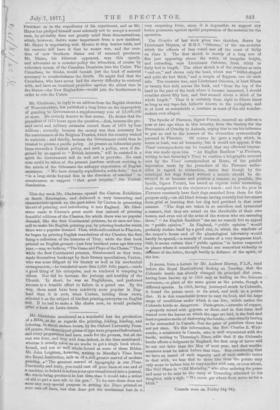It seems, from a lecture by Mr. Andrew Murray, F.L:S.,
road before the Royal Horticultural Society ou Tuesday, that the Colorado beetle has already changed its principal diet once, having been known up to 1858 only as feeding on the Solanuni rostratum,—a plant of the same genus as the potato, though a different species. In 1858, having journeyed south to Colorado, it found the potato more to its mind, and took to, a potato diet. It is this remarkable power to vary its food, and the large range of conditions under which it can live, which makes the Colorado bettle so dangerous. Paris-green,—arsenite of copper, —properly mixed with gypsum or flour, and in that form well dusted over the leaves on which the eggs are laid, is the best and least expensive mode of destroying the beetle,—this remedy having so far succeeded in Canada, that the price of potatoes there has not yet risen. To this information, the Rev. Charles E. Whit- combo, a missionary in Canada, who is well acquainted with the beetle, writing to Thursday's Times, adds that if the 'Colorado beetle effects a lodgment in England, the first crop of larvae will be out not later than the May of next year, and that warlike measures must be taken before that time. But considering that we have an insect of such sagacity and of such catholic tastes to deal with, we fear that to drive him from the potato may only moan to induce him to vary his diet with oats, or even wheat, like Niel Blane in " Old Mortality," who after ordering the pease and meal to be sent to the camp at Drumclog, admitted to his daughter, with a sigh, " We maim gar wheat-flour servo us for a blink."


































 Previous page
Previous page